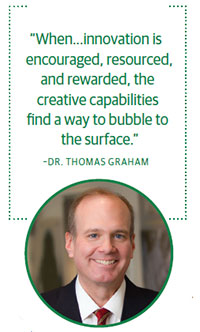For specialty hospital Cleveland Clinic, company culture has always revolved around the organization’s healthy appetite for innovation. Dr. Thomas Graham, former chief innovation officer for Cleveland Clinic, explains that innovation doesn’t happen overnight. It’s a non-linear, long-to-success, fraught-with-failure proposition.
“The journey has to be celebrated as much as the destination and one must exercise critical analysis, not just criticism,” Dr. Graham says. “For an innovative culture to take root at an organization or institution, there must be a champion—an evangelist that’s visible and has the trust of the highest-level leadership because, in fact, they’re one of them. When innovation becomes weaved into the cultural fabric of an organization, it becomes a core value and competency. From that moment forward, success will be defined differently and new avenues for expression will open.”
In his recent book, Innovation the Cleveland Clinic Way, Dr. Graham discusses how the organization’s 95-year history in the healthcare space spawned its pioneering, modern approach to innovation. While it hasn’t always been easy, the Clinic’s mission-driven dedication to improving and extending human life has always served as the principal catalyst for continued innovation for both patients and employees.
Customer Strategist: In your book, you explain that innovation remains at the heart of Cleveland Clinic’s culture. Why has this particular focus become the core driver behind your organization’s success?
Dr. Thomas Graham: Cleveland Clinic is one of the highest acuity hospitals in the world, meaning we take care of the sickest patients and most complex problems. This requires a level of creativity and collaboration that starts at the patient’s bedside, and can conclude with a breakthrough idea that advances technique and technology in healthcare delivery. Innovation, meaning reducing transcendent thought to practice, becomes a requirement and a sustainable pillar of our organization for these reasons.
CS: You also indicate that healthcare isn’t an industry that can allow others to solve its problems. How has your dedication to mission-driven innovation furthered your internal culture of problem solving and adaptability?
TG: Although healthcare and its adjacencies represent the largest concentrated sector of our American economy, it has characteristics that make it unique. We are an industry where our clients don’t want our service—they don’t want to be sick or injured. Traditionally, our clients (a.k.a. patients) don’t pay for our service. Third parties are the payers. With that as a foundation, healthcare also is the nexus of technology, education, inquiry and other aspects that define its need to be cutting edge, if not futuristic. For these and other reasons, healthcare must be introspective and prospective, and work to identify and solve problems in a way that translates for the entire world.
 CS: Describe your organization’s innovator philosophy. How have Cleveland Clinic’s 10 Commandments of Innovation impacted the way teams and individuals collaborate and create?
CS: Describe your organization’s innovator philosophy. How have Cleveland Clinic’s 10 Commandments of Innovation impacted the way teams and individuals collaborate and create?
TG: Simply put, the Clinic’s innovation has several basic elements, but can be united by a term that usually precedes the word innovation, and that’s mission-driven. What that means to us is that everything we do in the innovation realm is focused on improving and extending human life. We celebrate the innovator and appreciate the process, and have underscored the importance of discipline in its practice. We are also the greatest advocates of seeking collaboration around creative thought. Innovation happens best at the intersection of knowledge domains. Our 10 Commandments are guided by simple principles that serve to identify and perpetuate an innovation culture (see sidebar).
CS: How does Cleveland Clinic encourage and incentivize innovation among employees? How does your innovative infrastructure impact employee culture?
TG: Innovators should be encouraged, resourced, and rewarded. It starts with maintaining an infrastructure that serves to identify the organization around innovation and becomes recognized as the portal of entry for creative people to both “upload” and “download” information that connects them to the innovation ecosystem. Regarding reward, Cleveland Clinic has always maintained a very generous inventor remuneration policy. Because the institution, through the technology transfer, and corporate venturing arm Cleveland Clinic Innovations, provides the protection, development, and transactional power, the inventor directly benefits from this infrastructure and still shares in the upside in the form of a large percentage of the proceeds, without limitation, from any form of terminal transaction, such as royalty-bearing license or spin-off company. To date, Cleveland Clinic Innovations has returned over $80 million to our on-campus inventors.
CS: How have changes with the healthcare sector altered Cleveland Clinic’s approach to innovation over the years?
TG: When I started my innovation career a couple decades ago, I don’t believe that I appreciated the cost impacts that our advances brought to the marketplace. Today, value-based innovation is a critical approach we now appreciate. We are making sure that we seek solutions that increase access, improve outcome, and control costs.
CS: How have Cleveland Clinic Innovation Center’s Six Degrees of Innovation helped keep your team on track?
TG: The importance of maintaining capability in all Six Degrees has become the defining responsibility of today’s contemporary innovation leader: Opportunistic, Organic, Synthetic, Geographic, Strategic, and Telescopic. It reflects that innovation can be structured, amplified, and extracted if there is an appreciation that there’s not one “flavor” of innovation, and all of its manifestations must be appreciated and captured.
CS: What are some of the greatest inventions Cleveland Clinic has developed throughout its history of innovation?
TG: There have been so many that it is like choosing your favorite children. First, breakthroughs like the first blood transfusion, all the way to face transplant, are definite highlights. The isolation and synthesis of some of the world’s most important drugs—angiotensin and serotonin—or the invention of Military Anti-Shock Trousers (MAST) are more examples. At the end of the day, I would have to say the portfolio of advancements in cardiology and cardiac surgery is probably our innovation zenith—namely, Dr. Mason Sones’ discovery and development of coronary angiography.
What portends well for the future is that the Clinic’s early adoption of electronic medical records, and the immense talent and vision of the new generation of innovators, is now positioning Cleveland Clinic as a logical leader in healthcare information technologies. This may be the biggest growth industry that will affect healthcare transformation.
CS: How has the environment you’ve established facilitated the level of creativity you desire?
TG: Everyone knows his or her ideas are valuable. The greatest tragedy occurs when ideas lay fallow. There’s almost always latent innovation that is lurking beneath the surface at your organization. When you put your stake in the ground and send the message to your colleagues that innovation is encouraged, resourced, and rewarded, the creative capabilities find a way to bubble to the surface. Innovation is not a “carrot or stick” proposition, but instead it’s an innate capability maintained at almost every progressive institution that’s either extracted by surrounding it with a disciplined practice, or sometimes left unrequited by failing to nurture it.
CS: How will you continue to nurture this culture of innovation moving forward?
TG: If I were to pick one defining margin of difference...it would be the embrace of collaboration. Innovation happens best at the intersection of knowledge domain. Traditional vendor-client relationships can become partnerships and even historical competitors can become collaborators. To optimize innovation’s impact on the future of healthcare openness to creative partnerships will be required.






